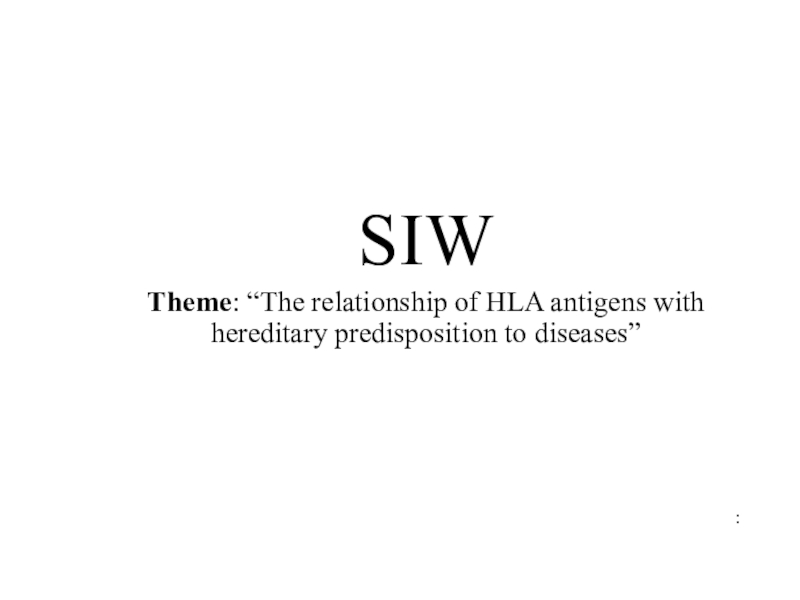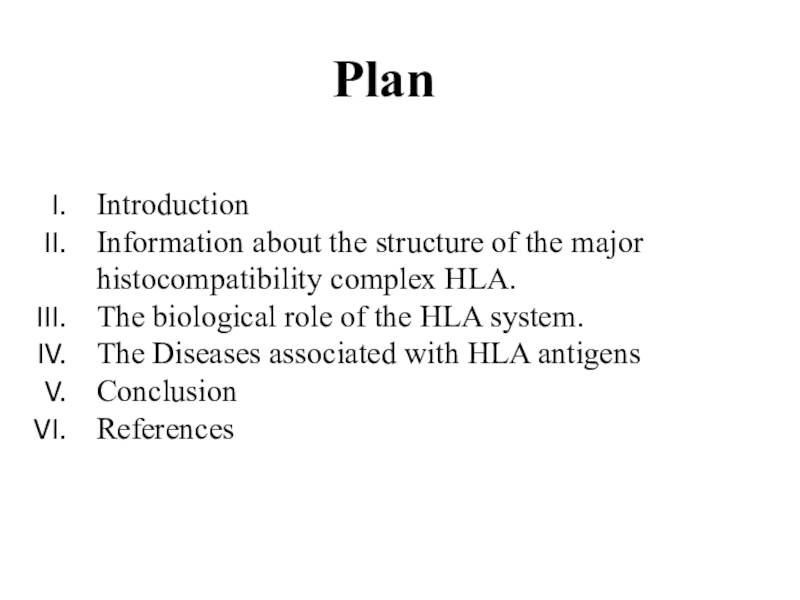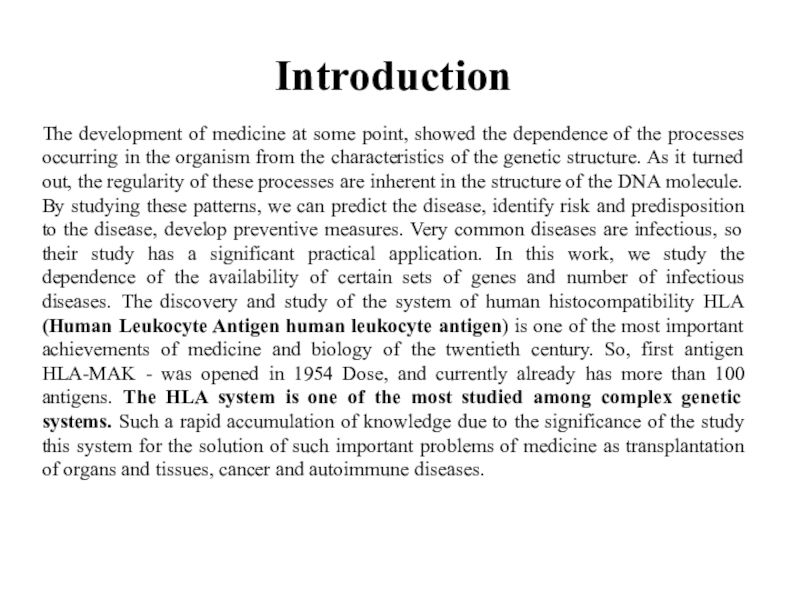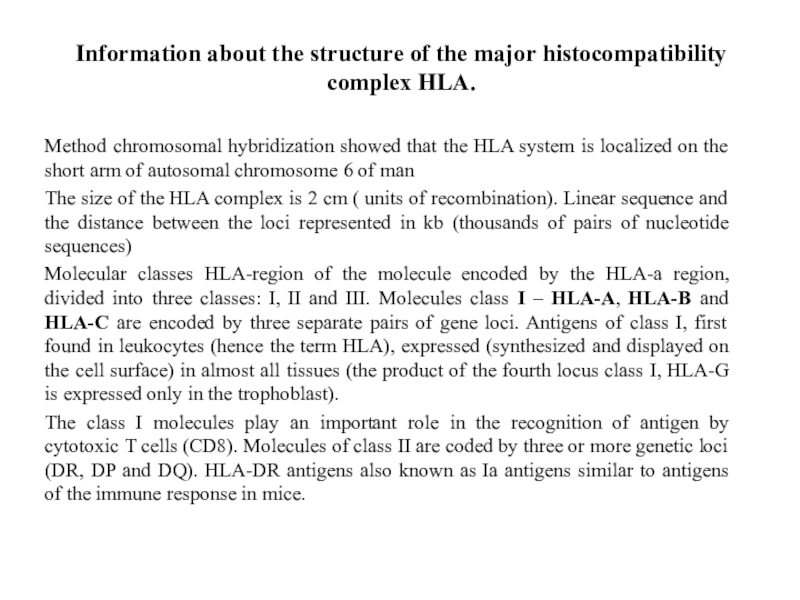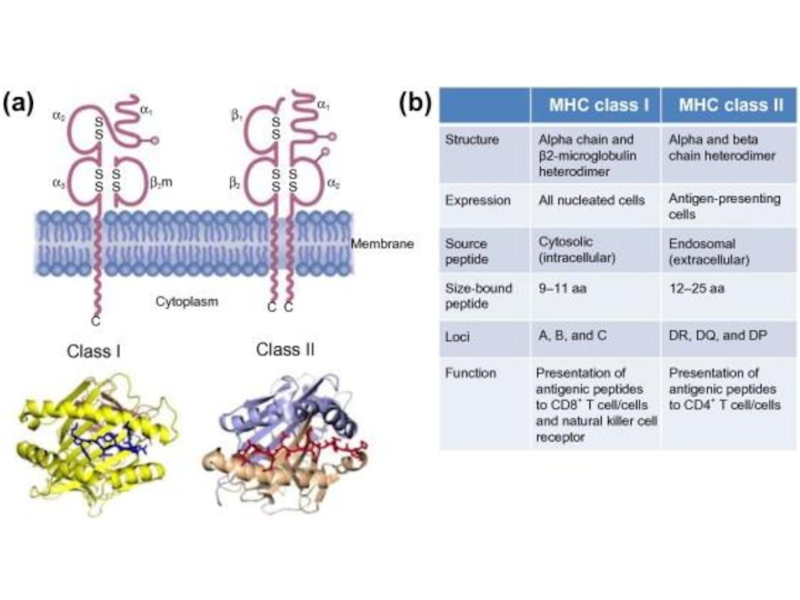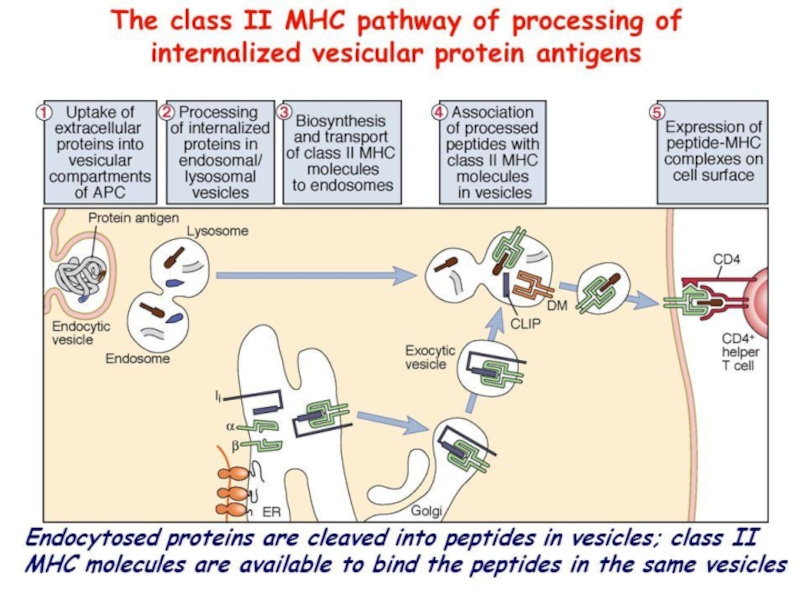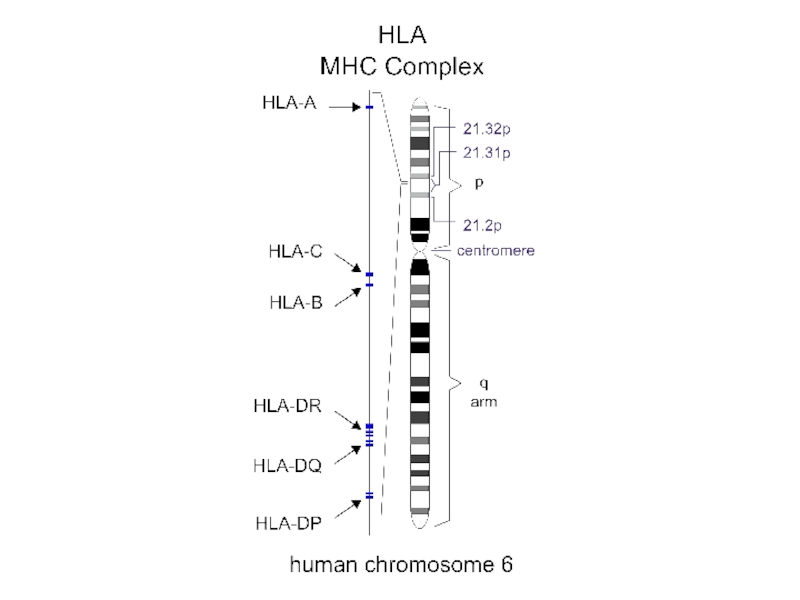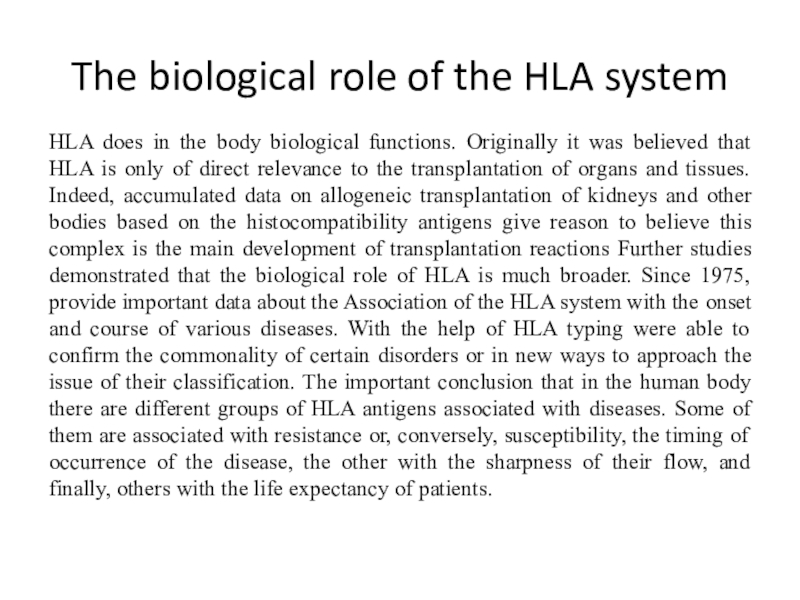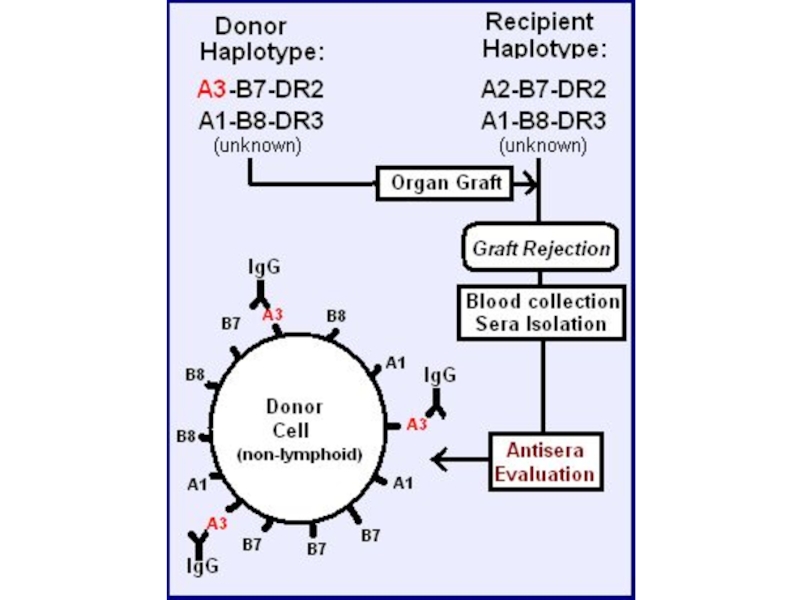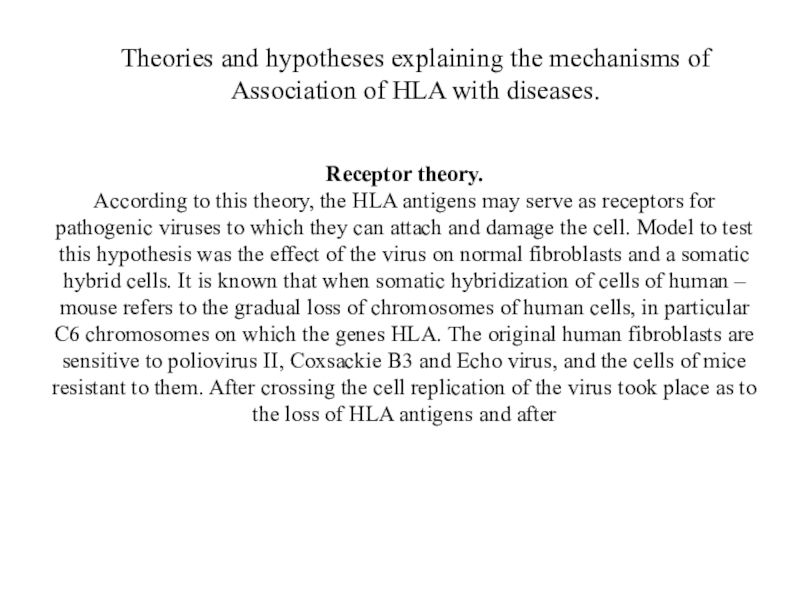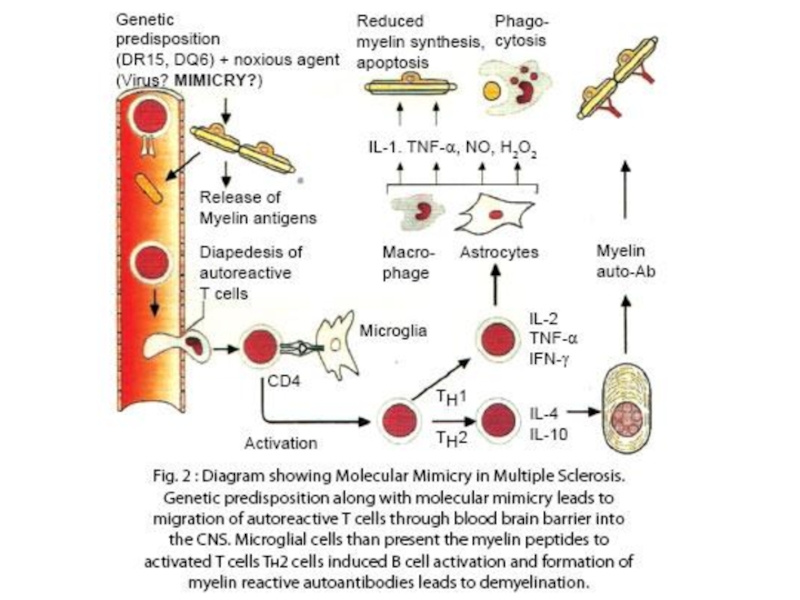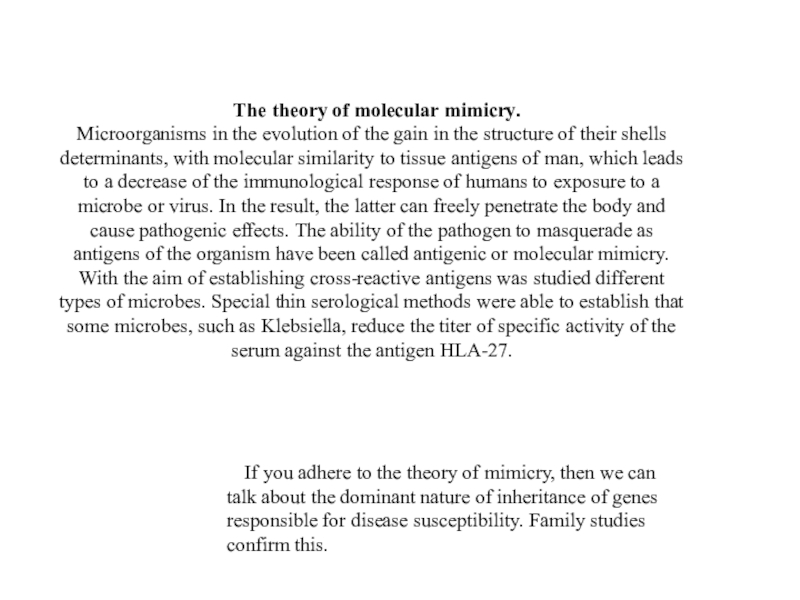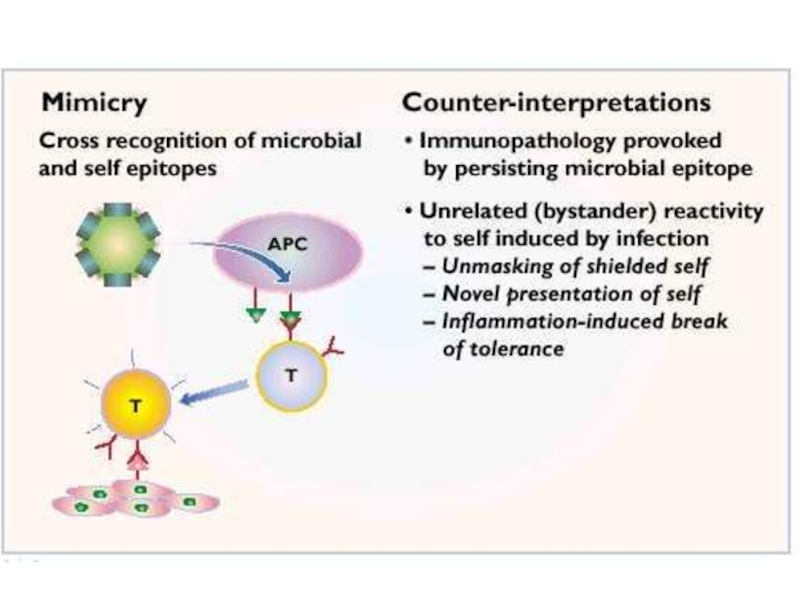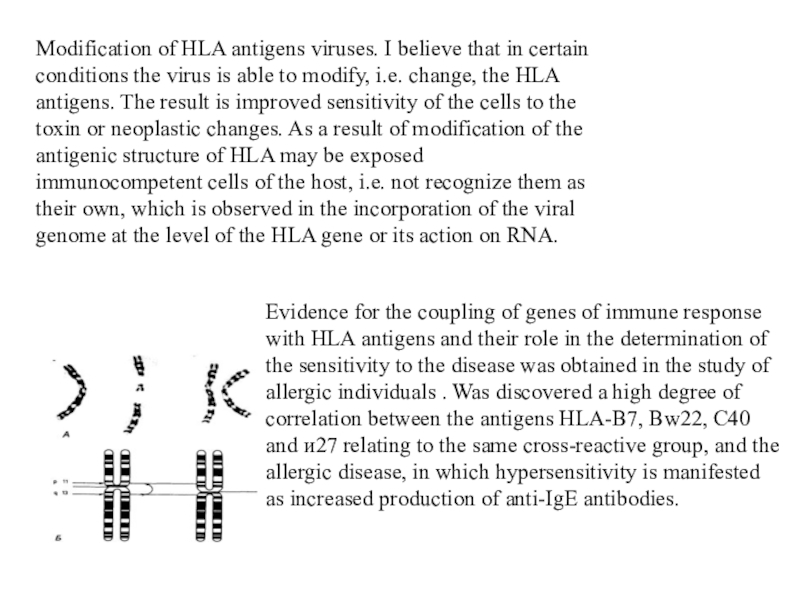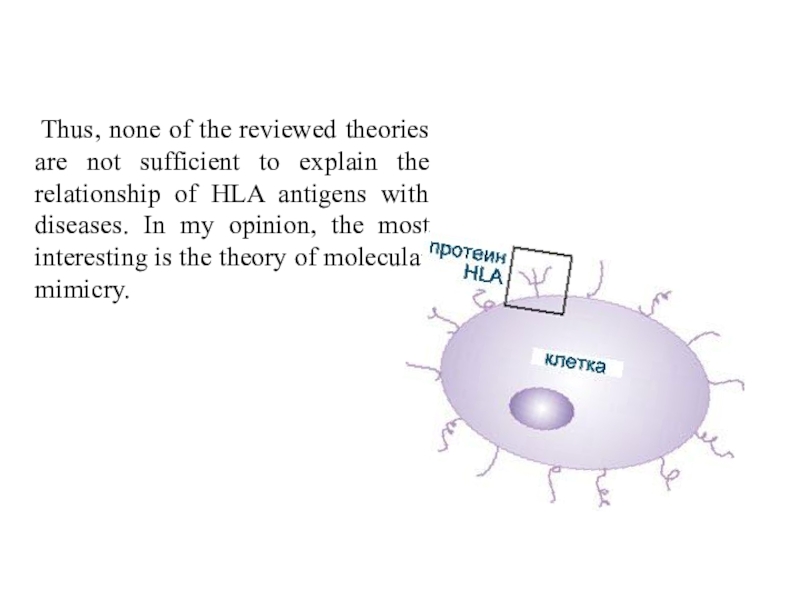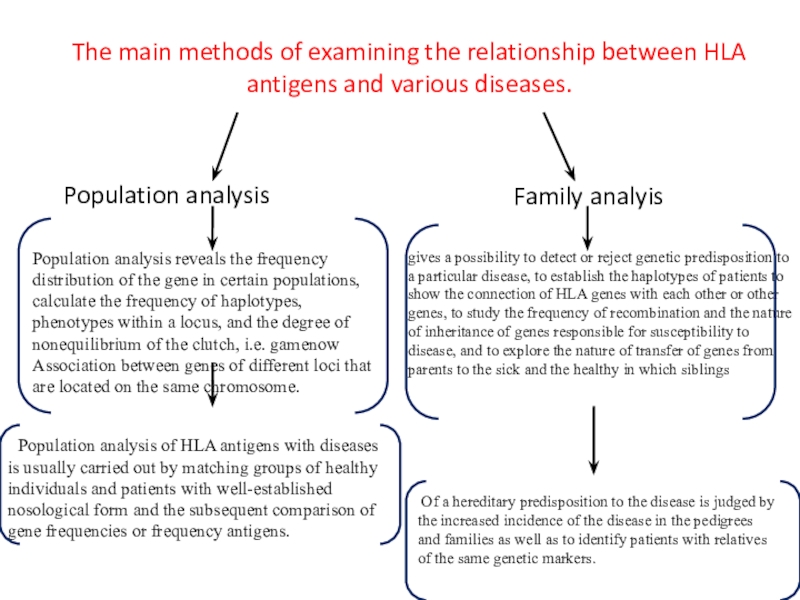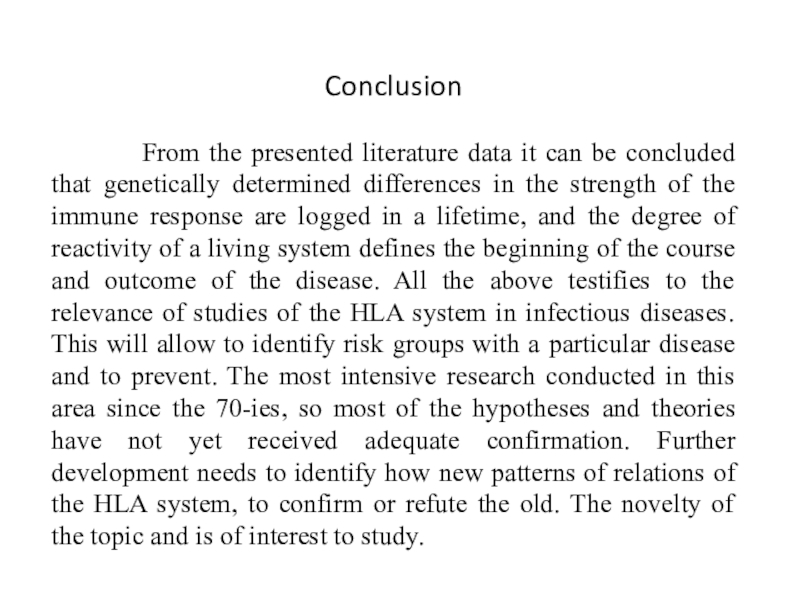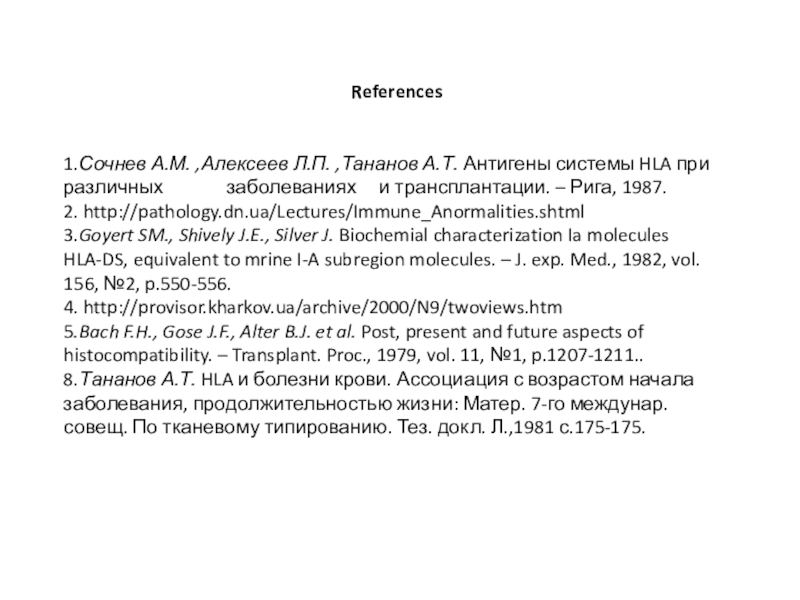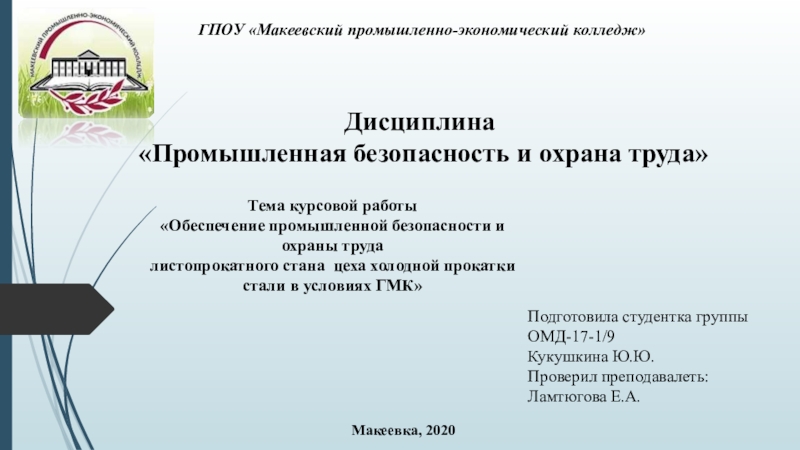Разделы презентаций
- Разное
- Английский язык
- Астрономия
- Алгебра
- Биология
- География
- Геометрия
- Детские презентации
- Информатика
- История
- Литература
- Математика
- Медицина
- Менеджмент
- Музыка
- МХК
- Немецкий язык
- ОБЖ
- Обществознание
- Окружающий мир
- Педагогика
- Русский язык
- Технология
- Физика
- Философия
- Химия
- Шаблоны, картинки для презентаций
- Экология
- Экономика
- Юриспруденция
SIW Theme : “The relationship of HLA antigens with hereditary predisposition to
Содержание
- 1. SIW Theme : “The relationship of HLA antigens with hereditary predisposition to
- 2. PlanIntroduction Information about the structure of the
- 3. Introduction The development of medicine at some
- 4. Information about the structure of the major
- 5. Слайд 5
- 6. Слайд 6
- 7. Слайд 7
- 8. The biological role of the HLA systemHLA
- 9. Слайд 9
- 10. Receptor theory. According to this theory, the
- 11. Слайд 11
- 12. The theory of molecular mimicry. Microorganisms
- 13. Слайд 13
- 14. Modification of HLA antigens viruses. I believe
- 15. Thus, none of the reviewed theories are
- 16. The main methods of examining the relationship
- 17. Conclusion From the
- 18. References1.Сочнев А.М. ,Алексеев Л.П. ,Тананов А.Т. Антигены системы
- 19. Скачать презентанцию
Слайды и текст этой презентации
Слайд 2Plan
Introduction
Information about the structure of the major histocompatibility complex
HLA.
The biological role of the HLA system.
The Diseases associated
with HLA antigens Conclusion
References
Слайд 3Introduction
The development of medicine at some point, showed the dependence
of the processes occurring in the organism from the characteristics
of the genetic structure. As it turned out, the regularity of these processes are inherent in the structure of the DNA molecule. By studying these patterns, we can predict the disease, identify risk and predisposition to the disease, develop preventive measures. Very common diseases are infectious, so their study has a significant practical application. In this work, we study the dependence of the availability of certain sets of genes and number of infectious diseases. The discovery and study of the system of human histocompatibility HLA (Human Leukocyte Antigen human leukocyte antigen) is one of the most important achievements of medicine and biology of the twentieth century. So, first antigen HLA-MAK - was opened in 1954 Dose, and currently already has more than 100 antigens. The HLA system is one of the most studied among complex genetic systems. Such a rapid accumulation of knowledge due to the significance of the study this system for the solution of such important problems of medicine as transplantation of organs and tissues, cancer and autoimmune diseases.Слайд 4Information about the structure of the major histocompatibility complex HLA.
Method
chromosomal hybridization showed that the HLA system is localized on
the short arm of autosomal chromosome 6 of manThe size of the HLA complex is 2 cm ( units of recombination). Linear sequence and the distance between the loci represented in kb (thousands of pairs of nucleotide sequences)
Molecular classes HLA-region of the molecule encoded by the HLA-a region, divided into three classes: I, II and III. Molecules class I – HLA-A, HLA-B and HLA-C are encoded by three separate pairs of gene loci. Antigens of class I, first found in leukocytes (hence the term HLA), expressed (synthesized and displayed on the cell surface) in almost all tissues (the product of the fourth locus class I, HLA-G is expressed only in the trophoblast).
The class I molecules play an important role in the recognition of antigen by cytotoxic T cells (CD8). Molecules of class II are coded by three or more genetic loci (DR, DP and DQ). HLA-DR antigens also known as Ia antigens similar to antigens of the immune response in mice.
Слайд 8The biological role of the HLA system
HLA does in the
body biological functions. Originally it was believed that HLA is
only of direct relevance to the transplantation of organs and tissues. Indeed, accumulated data on allogeneic transplantation of kidneys and other bodies based on the histocompatibility antigens give reason to believe this complex is the main development of transplantation reactions Further studies demonstrated that the biological role of HLA is much broader. Since 1975, provide important data about the Association of the HLA system with the onset and course of various diseases. With the help of HLA typing were able to confirm the commonality of certain disorders or in new ways to approach the issue of their classification. The important conclusion that in the human body there are different groups of HLA antigens associated with diseases. Some of them are associated with resistance or, conversely, susceptibility, the timing of occurrence of the disease, the other with the sharpness of their flow, and finally, others with the life expectancy of patients.Слайд 10Receptor theory.
According to this theory, the HLA antigens may
serve as receptors for pathogenic viruses to which they can
attach and damage the cell. Model to test this hypothesis was the effect of the virus on normal fibroblasts and a somatic hybrid cells. It is known that when somatic hybridization of cells of human – mouse refers to the gradual loss of chromosomes of human cells, in particular C6 chromosomes on which the genes HLA. The original human fibroblasts are sensitive to poliovirus II, Coxsackie B3 and Echo virus, and the cells of mice resistant to them. After crossing the cell replication of the virus took place as to the loss of HLA antigens and afterTheories and hypotheses explaining the mechanisms of Association of HLA with diseases.
Слайд 12 The theory of molecular mimicry.
Microorganisms in the evolution
of the gain in the structure of their shells determinants,
with molecular similarity to tissue antigens of man, which leads to a decrease of the immunological response of humans to exposure to a microbe or virus. In the result, the latter can freely penetrate the body and cause pathogenic effects. The ability of the pathogen to masquerade as antigens of the organism have been called antigenic or molecular mimicry. With the aim of establishing cross-reactive antigens was studied different types of microbes. Special thin serological methods were able to establish that some microbes, such as Klebsiella, reduce the titer of specific activity of the serum against the antigen HLA-27. If you adhere to the theory of mimicry, then we can talk about the dominant nature of inheritance of genes responsible for disease susceptibility. Family studies confirm this.
Слайд 14Modification of HLA antigens viruses. I believe that in certain
conditions the virus is able to modify, i.e. change, the
HLA antigens. The result is improved sensitivity of the cells to the toxin or neoplastic changes. As a result of modification of the antigenic structure of HLA may be exposed immunocompetent cells of the host, i.e. not recognize them as their own, which is observed in the incorporation of the viral genome at the level of the HLA gene or its action on RNA.Evidence for the coupling of genes of immune response with HLA antigens and their role in the determination of the sensitivity to the disease was obtained in the study of allergic individuals . Was discovered a high degree of correlation between the antigens HLA-B7, Bw22, C40 and и27 relating to the same cross-reactive group, and the allergic disease, in which hypersensitivity is manifested as increased production of anti-IgE antibodies.
Слайд 15 Thus, none of the reviewed theories are not sufficient to
explain the relationship of HLA antigens with diseases. In my
opinion, the most interesting is the theory of molecular mimicry.Слайд 16The main methods of examining the relationship between HLA antigens
and various diseases.
Population analysis
Family analyis
Population analysis reveals the frequency
distribution of the gene in certain populations, calculate the frequency of haplotypes, phenotypes within a locus, and the degree of nonequilibrium of the clutch, i.e. gamenow Association between genes of different loci that are located on the same chromosome. Population analysis of HLA antigens with diseases is usually carried out by matching groups of healthy individuals and patients with well-established nosological form and the subsequent comparison of gene frequencies or frequency antigens.
gives a possibility to detect or reject genetic predisposition to a particular disease, to establish the haplotypes of patients to show the connection of HLA genes with each other or other genes, to study the frequency of recombination and the nature of inheritance of genes responsible for susceptibility to disease, and to explore the nature of transfer of genes from parents to the sick and the healthy in which siblings
Of a hereditary predisposition to the disease is judged by the increased incidence of the disease in the pedigrees and families as well as to identify patients with relatives of the same genetic markers.
Слайд 17Conclusion
From the presented literature data
it can be concluded that genetically determined differences in the
strength of the immune response are logged in a lifetime, and the degree of reactivity of a living system defines the beginning of the course and outcome of the disease. All the above testifies to the relevance of studies of the HLA system in infectious diseases. This will allow to identify risk groups with a particular disease and to prevent. The most intensive research conducted in this area since the 70-ies, so most of the hypotheses and theories have not yet received adequate confirmation. Further development needs to identify how new patterns of relations of the HLA system, to confirm or refute the old. The novelty of the topic and is of interest to study.Слайд 18References
1.Сочнев А.М. ,Алексеев Л.П. ,Тананов А.Т. Антигены системы HLA при различных
заболеваниях и трансплантации. – Рига, 1987.
2. http://pathology.dn.ua/Lectures/Immune_Anormalities.shtml
3.Goyert SM., Shively J.E.,
Silver J. Biochemial characterization Ia molecules HLA-DS, equivalent to mrine I-A subregion molecules. – J. exp. Med., 1982, vol. 156, №2, p.550-556.4. http://provisor.kharkov.ua/archive/2000/N9/twoviews.htm
5.Bach F.H., Gose J.F., Alter B.J. et al. Post, present and future aspects of histocompatibility. – Transplant. Proc., 1979, vol. 11, №1, p.1207-1211..
8.Тананов А.Т. HLA и болезни крови. Ассоциация с возрастом начала заболевания, продолжительностью жизни: Матер. 7-го междунар. совещ. По тканевому типированию. Тез. докл. Л.,1981 с.175-175.
